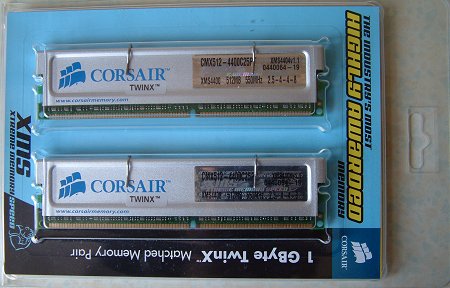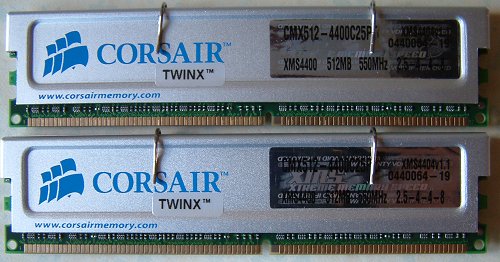Appearance and thoughts
DDR1 RAM that's specified to run at DDR500+ speeds is usually accompanied by looser timings than on premium PC3200 memory. That's just the way it is, unfortunately. Higher timings erode some of the advantages that high frequency offers, so the choice between, say, 2-2-2-5 PC3200 RAM, run either synchronously or asynchronously, and 3-4-4-8 PC4000+ RAM, is a difficult one to make. Higher native timings also dictate that high-speed RAM should only be considered if you absolutely know that your setup can make use of it. There's very little point, in my opinion, to even contemplate a purchase if you can't verify that your motherboard is capable of at least matching the RAM's default speed.
Overclocking multiplier-locked (upwards) CPUs can only be achieved by ramping up the Front-Side Bus or driven clock. Corsair's XMS4400 TwinX 1GByte pack is designed to appeal to those who don't want synchronous RAM to become the overclocking limiting factor until at least 275MHz, or DDR550 speeds. What's more, Corsair advertises the fact that its fastest memory runs with 2.5-4-4-8 timings. Dropping from the usual CAS latency of 3 clocks to 2.5 isn't going to make a great deal of real-world difference, but Corsair's cottoned on to the fact that it's a good marketing and advertising tool.

Twinx XMS4400 ships with regular aluminium heatspreaders in place. These help neutralise any localised hotspots when running it at a recommended 2.75v. Most premium memory, be it low latency or high speed, tends to be specified between 2.7-2.9v, so Corsair's voltage recommendation is directly in line with the competition's. The back of the modules hold no surprises.

A closer look at the funky Corsair hologram highlights the model number, CMX512-4400C25PT, and the RAM's native timings of 2.5-4-4-8 (CAS-TRCD-TRP-TRAS). It's exactly half a CAS latency faster than most other DDR550-capable RAM. CAS latency can be defined as the time, in clock cycles, between when a command is issued and read from a particular memory column. The impact of CAS latency on performance is dependant on a huge array of factors, but, generally speaking, less latency is always positively impacts performance.
DDR550 memory requires higher latencies than DDR400 parts simply because the faster speeds just don't give RAM the time needed to spit out data in, say, 2-2-2-5 settings. Taking that further and CAS latency as the obvious example, it's a derivation of column access time and clock cycle time, and CLK (clock cycle time) reduces as MHz rises, so column access time needs to be reduced to conform to a particular CAS latency setting. It's a balancing game between overall speed (MHz) and quickness of response (low latencies).

Corsair has used identical Samsung ICs on this XMS4400 line as on its 2-2-2-5 XL PRO RAM. Mushkin, Kingston and OCZ, to name but a few, have also used Samsung's K4H560838F-TCCD chips, although usually with tighter timings and PC3200 speeds. It seems as if these ICs are wonderfully versatile, right from DDR400 through to DDR550+. Previous modules with these ICs haven't been able to hit the stratospheric heights of DDR550, so it seems as if Corsair has tinkered with the PCB-based components here.









